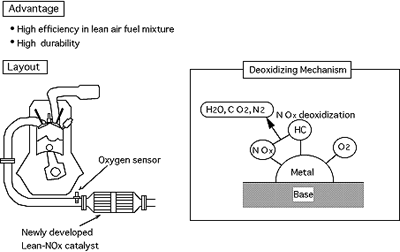
II.Major Objectives of the GDI engine
1.The difference between new GDI and current MPI
2.Outline
3.Technical features
III. Major characteristics of the GDI engine
1.Lower fuel consumption and higher output
2.Realization of lower fuel consumption
3.Realization of Superior Output
![]()

Animation

(2) Combustion of Ultra-lean Mixture
![]() In conventional MPI engines, there were limits to the mixtures leanness due to large changes in combustion characteristics. However, the stratified mixture of the GDI enabled greatly decreasing the air-fuel ratio without leading to poorer combustion. For example, during idling when combustion is most inactive and unstable, the GDI engine maintains a stable and fast combustion even with an extremely lean mixture of 40 to 1 air-fuel ratio (55 to 1, EGR included)
In conventional MPI engines, there were limits to the mixtures leanness due to large changes in combustion characteristics. However, the stratified mixture of the GDI enabled greatly decreasing the air-fuel ratio without leading to poorer combustion. For example, during idling when combustion is most inactive and unstable, the GDI engine maintains a stable and fast combustion even with an extremely lean mixture of 40 to 1 air-fuel ratio (55 to 1, EGR included)
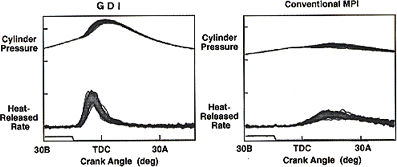
(3) Vehicle Fuel Consumption
Fuel Consumption During Idling
The GDI engine maintains stable combustion even at low idle speeds. Moreover,
it offers greater flexibility in setting the idle speed.
Compared to conventional engines, its fuel consumption during idling is 40% less.
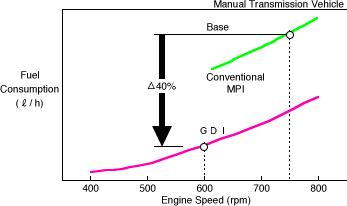
Fuel Consumption during Cruising Drive
At 40km/h, for example, the GDI engine uses 35% less fuel than a comparably sized conventional engine.
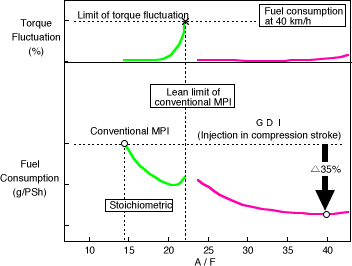
Fuel Consumption in City Driving
In Japanese 10ÅE15 mode tests ( representative of typical japanese urban driving ), the GDI engine used 35% less fuel than comparably sized conventional gasoline engines. Moreover, these results indicate that the GDI engine uses less fuel than even diesel engines.
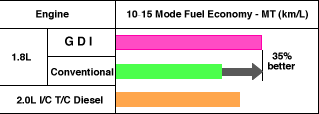
Emission Control
Previous efforts to burn a lean air-fuel mixture have resulted in difficulty to control NOx emission. However, in the case of GDI engine, 97% NOx reduction is achieved by utilizing high-rate EGR (Exhaust Gas Ratio) such as 30% that is allowed by the stable combustion unique to the GDI as well as a use of a newly developed lean-NOx catalyst.
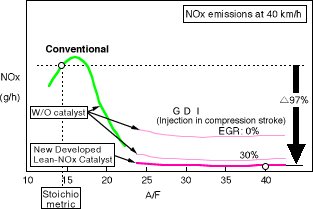
Newly Developed Lean NOx Catalyst (HC selective deoxidization type)
